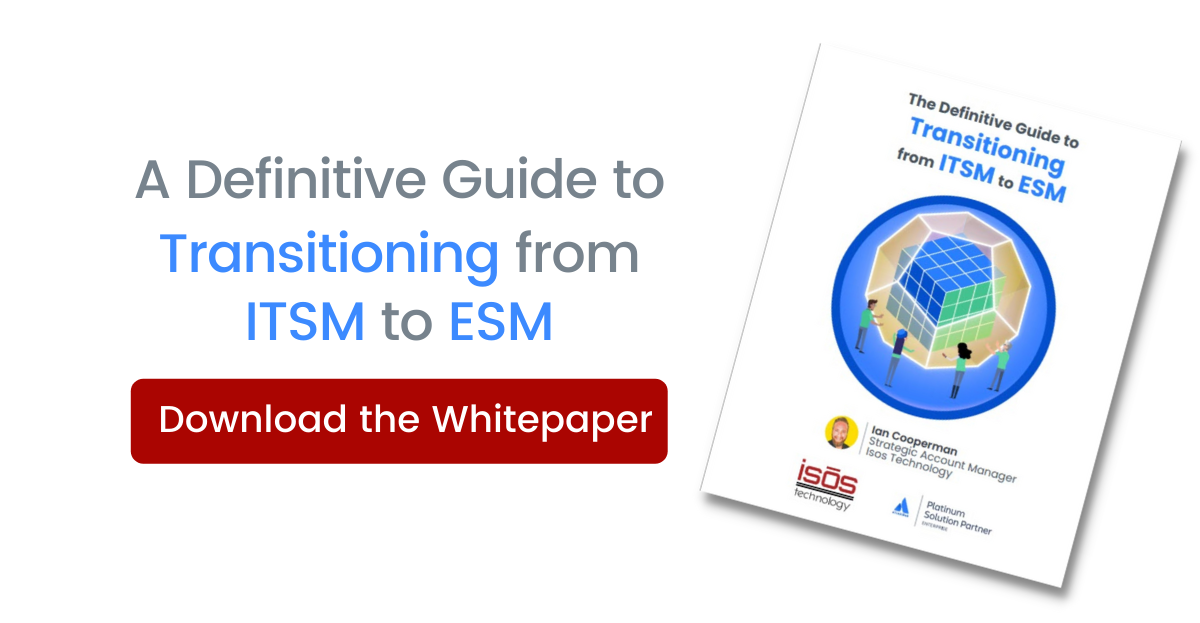 ITSM, or IT Service Management, refers to the practice of managing the end-to-end delivery of IT services to both internal and external customers.
ITSM, or IT Service Management, refers to the practice of managing the end-to-end delivery of IT services to both internal and external customers.
Regarding service management, internal users expect more than an artificial intelligence (AI) response. They want issues preventing them from completing their work to be quickly resolved or to make employee onboarding more seamless.
When it comes to service management, internal users expect more than just an artificial intelligence (AI) response. They want quick resolutions to issues that hinder their work and more seamless onboarding experiences. External users are looking for better customer service as well. For instance, they might want a financial institution to improve service and respond to technical issues through an online portal.
ITSM already encompasses a wide range of practices, so what will it look like when we start incorporating Enterprise Service Management as well?
Quick take: Enterprise Service Management (ESM)
Enterprise Service Management (ESM) may not be as familiar as ITSM. ESM refers to taking ITSM tools and best practices and extending them to other departments beyond IT. Here are some key points to know about ESM and Enterprise Service Management software:
- What is Enterprise Service Management? It's often called ESM and extends IT Service Management and ITSM principles.
- ESM uses a single application or platform to manage processes across departments while unifying, standardizing, and automating service delivery to improve efficiency, performance, and outcomes.
- It can help businesses manage supply and demand by accelerating service access and delivery and improving visibility throughout all project management.
- ESM can also streamline departments such as IT, HR, legal, marketing, finance, and facilities management.
- With ESM, business teams drive innovation, collaboration, agility, and scalability from one platform.
- Examples of ESM in action include building a service desk that can be utilized across all organizational departments or configuring workflows in a service management tool to match one business unit's specific service delivery needs.
ITSM vs. ESM operations and practices: What’s the difference?
To better understand the difference between ITSM and ESM, it’s important to consider the two concepts as not opposing one another but in congruence with each other. Enterprise Service Management functions as an expansion of IT Service Management, so essentially, it’s ITSM plus ESM, not an either/or decision.
The main goal of a great ITSM implementation is unifying all teams throughout an organization by standardizing services and streamlining workflows. Enterprise Service Management pulls the best, most tried-and-true processes from existing ITSM principles and adopts these principles to satisfy the unique business needs of each department. This ensures that everyone throughout the organization is on the same page and can have access to information that will assist their needs.
Are the services similar? Yes, but that doesn’t mean you necessarily have to choose between the two. ITSM enhances how organizations approach, experience, and manage IT software services. At the same time, ESM more broadly applies those service management practices and goals to all aspects of the business, not just IT.
Think of this implementation as a puzzle, where ITSM tools are crucial edge pieces, while ESM is the picture of the box, so you know the quality of the whole solution. With the enormous scope of an Enterprise Service Management strategy, you can simplify and reduce processes, cut costs, and have all departments work within one platform. Not bad when a day’s work is better for employees, management, and end users.
How ESM enables digital transformation and support
As businesses scale and embark on digital transformation, the gaps between different departments start to become more pronounced. Although ESM isn’t a full-scale digital transformation itself, it facilitates digital transformation in a number of ways, as the capabilities are endless.
Clarifying services and improvements
At enterprise-level organizations, there isn’t much visibility into the day-to-day operations of each team for the rest of the company. Instead of pinging your coworkers on Slack for specific content documentation or requesting support services, ESM alleviates the pain and lack of knowledge management by assisting organizations in articulating and providing those services consistently through a unified portal, which is accessible 24/7.
Breaking down one internal silo at a time
Oftentimes, different teams throughout an organization must work closely with one another to deliver services to end users. This process is usually done manually, which makes it prone to errors. ESM software can help teams define a consistent workflow with an automated process, ensuring that mistakes aren’t being made as they work together.
Automation effectively drives efficiency
When each department displays its services through a digital catalog, processes can be easily identified and tracked, and automating those processes can speed up service delivery.
Streamline control, governance, and organization
What gets tracked can be measured, so having a system that allows you to define services across all teams will enable organizations to centralize and streamline work. Implementing an ITSM or ESM solution and coordinating between teams can be difficult, but it may be time to embrace how an enterprise-wide solution can provide more value, organization, and unity than you thought possible.
So, what Is Enterprise Service Management? It’s the answer
The bottom line is that getting to know different platforms and practices is just the starting point of Enterprise Service Management and the functionalities it provides for service processes. Atlassian and Isos are here to help your organization succeed with ITSM and ESM, so don’t hesitate to reach out for more information on the benefits an ESM strategy could provide.
Sign up to receive more great content
Learn more about Atlassian and how Isos can help by signing up to receive our latest blogs, eBooks, whitepapers and more.














